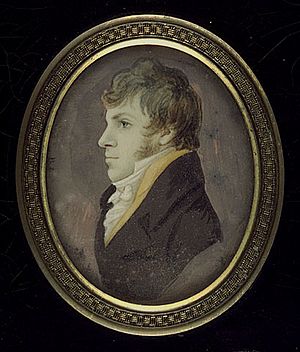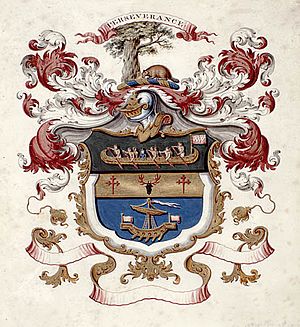Simon McGillivray facts for kids
Quick facts for kids
Simon McGillivray
|
|
|---|---|

Courtesy of the Library & Archives Canada
|
|
| Born | 1785 Dunlichty, Inverness-shire. Scotland
|
| Died | 9 June 1840 (aged 54–55) Blackheath, Kent, England
|
Simon McGillivray (born around 1785, died June 9, 1840) was an important businessman. He helped combine two big fur trading companies: the North West Company and the Hudson's Bay Company. He also owned parts of newspapers like the Morning Chronicle. Simon was a leader in a group called the Freemasons in Upper Canada. He was also a member of the Royal Society in London.
Early Life and Family
Simon McGillivray was born in 1785 in a place called Dunlichity, in the Scottish Highlands. He was the youngest son of Donald Roy McGillivray and Anne McTavish. His family had lived in the Dunmaglass area for a very long time.
Simon's family wasn't rich. His father was a small farmer and couldn't pay for Simon or his brothers, William and Duncan, to go to high school. Luckily, their rich uncle, Simon McTavish, helped them. He paid for their education and gave them jobs in his fur trading business.
Working in London
Simon McGillivray had a physical challenge: one of his feet was lame, and he couldn't see well with one eye. Because of this, he didn't go to the Canadas to work as a fur trader like his brothers. Instead, he went to London.
In London, Simon worked for a company called McTavish, Fraser & Co. This company was part of his uncle's big business. Their job was to help the Canadian fur trading company. They bought goods for trade, got money for the business, managed shipments, and sold the animal furs in London.
Simon became a partner in this company in 1805. By 1811, he was also a partner in the main company in Montreal. From London, Simon worked closely with his brother, William McGillivray. They worked hard to deal with their rivals, the Hudson's Bay Company. Simon traveled to Montreal when needed, but mostly stayed in London. His power in the company grew steadily over time.
Joining Two Big Companies
By 1820, the North West Company (NWC) was having big problems. William McGillivray realized they might collapse unless they made a deal with their rivals, the Hudson's Bay Company (HBC). Simon McGillivray took a main role in solving this.
Simon and his friend Edward Ellice came up with a plan to combine the two huge fur trading companies. During their talks, someone said that Simon had a "highland pride and frankness." This meant he was honest and proud of his Scottish roots.
The merger was finished in 1821. Simon McGillivray told the other partners in Canada the news. It was said that Simon handled everything smoothly. He opened the discussion on the first day, the agreement was signed on the second, and by the third day, everyone was getting along.
Simon and William became part of the new company's board. They invested a lot of money, but the peace didn't last long. By 1825, their companies in Montreal and London went bankrupt. They ended up owing a lot of money.
Later Life and Family
Simon McGillivray had to sell his valuable art collection because of the bankruptcy. However, his skills were still recognized in London, and his career continued to do well.
In 1829, Simon was chosen by a mining company in London to go to Mexico. His job was to help organize the company's silver mines there. By 1835, he was back in London. He became a co-owner of two newspapers, the Morning Chronicle and the London Advertiser.
Simon was also a Freemason in London. From 1822 until his death, he was the Provincial Grand Master of Upper Canada. In 1838, he was chosen to be a Fellow of the Royal Society.
In 1837, Simon married Anne Easthope in London. She was the oldest daughter of his business partner, Sir John Easthope. The McGillivrays had two homes. One was in London, and the other was in Blackheath. Simon was the godfather of John Auldjo. Simon and Anne had two daughters, but only one survived.
- Mary Louisa McGillivray (1840–1897) later married Rear-Admiral Richard Dawkins. They had five children together.



